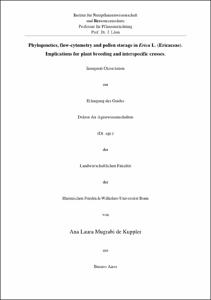Phylogenetics, flow-cytometry and pollen storage in Erica L. (Ericaceae)Implications for plant breeding and interspecific crosses

Phylogenetics, flow-cytometry and pollen storage in Erica L. (Ericaceae)
Implications for plant breeding and interspecific crosses

| dc.contributor.advisor | Léon, Jens | |
| dc.contributor.author | Mugrabi de Kuppler, Ana Laura | |
| dc.date.accessioned | 2020-04-18T13:45:42Z | |
| dc.date.available | 2020-04-18T13:45:42Z | |
| dc.date.issued | 05.12.2013 | |
| dc.identifier.uri | https://hdl.handle.net/20.500.11811/5565 | |
| dc.description.abstract | With over 840 species Erica L. is one of the largest genera of the Ericaceae, comprising woody perennial plants that occur from Scandinavia to South Africa. According to previous studies, the northern species, present in Europe and the Mediterranean, form a paraphyletic, basal clade, and the southern species, present in South Africa, form a robust monophyletic group. In this work a molecular phylogenetic analysis from European and from Central and South African Erica species was performed using the chloroplast regions: trnL-trnL-trnF and 5´trnK-matK, as well as the nuclear DNA marker ITS, in order i) to state the monophyly of the northern and southern species, ii) to determine the phylogenetic relationships between the species and contrasting them with previous systematic research studies and iii) to compare the results provided from nuclear data and explore possible evolutionary patterns. All species were monophyletic except for the widely spread E. arborea, and E. manipuliflora. The paraphyly of the northern species was also confirmed, but three taxa from Central East Africa were polyphyletic, suggesting different episodes of colonization of this area. The inheritance path of chloroplast markers and the mitochondria region cox3 from the analysis of a controlled hybrid and its parents was tested. The maternal inheritance of organelles is described for the first time in Erica, enabling the hypothesis that incongruences between chloroplast and ITS marker trees may be the result of a reticulate evolution within the genus. An approximation of nuclear DNA amount by the quantification of the relative genome amount via flow cytometry with DAPI was assayed for selected samples, all revealing to have a similar genome size, with the exception of E. bauera that seemed to present a higher ploidy level. The vitality test of pollen grains after storage from two Erica species was carried out using a FDA solution and applying UV-light fluorescence microscopy techniques with a positive yield of up to two living cells within the pollen tetrad after finalizing the storage period. | en |
| dc.language.iso | eng | |
| dc.rights | In Copyright | |
| dc.rights.uri | http://rightsstatements.org/vocab/InC/1.0/ | |
| dc.subject | Erica | |
| dc.subject | Ericacea | |
| dc.subject | Genomgröße | |
| dc.subject | Pollenvitalität | |
| dc.subject | Organellen-Vererbung | |
| dc.subject | phylogeny | |
| dc.subject | genome size | |
| dc.subject | pollen vitality | |
| dc.subject | organelle inheritance | |
| dc.subject.ddc | 630 Landwirtschaft, Veterinärmedizin | |
| dc.title | Phylogenetics, flow-cytometry and pollen storage in Erica L. (Ericaceae) | |
| dc.title.alternative | Implications for plant breeding and interspecific crosses | |
| dc.type | Dissertation oder Habilitation | |
| dc.publisher.name | Universitäts- und Landesbibliothek Bonn | |
| dc.publisher.location | Bonn | |
| dc.rights.accessRights | openAccess | |
| dc.identifier.urn | https://nbn-resolving.org/urn:nbn:de:hbz:5n-34286 | |
| ulbbn.pubtype | Erstveröffentlichung | |
| ulbbnediss.affiliation.name | Rheinische Friedrich-Wilhelms-Universität Bonn | |
| ulbbnediss.affiliation.location | Bonn | |
| ulbbnediss.thesis.level | Dissertation | |
| ulbbnediss.dissID | 3428 | |
| ulbbnediss.date.accepted | 15.11.2013 | |
| ulbbnediss.fakultaet | Landwirtschaftliche Fakultät | |
| dc.contributor.coReferee | Fagúndez, Jaime |
Dateien zu dieser Ressource
Das Dokument erscheint in:
-
E-Dissertationen (1118)




